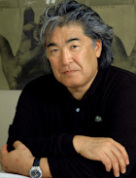
White Light/Black Rain: The Destruction of Hiroshima and Nagasaki| 1hr : 25mins
Director: Steven Okazaki | Producer: Steven Okazaki
Focus Years: 2007 | Country: United States
Synopsis:
On Aug. 6 and 9, 1945, two atomic bombs vaporized 210,000 people in Hiroshima and Nagasaki. Those who survived, of which there are an estimated 200,000 living today, are called 'hibakusha' — people exposed to the bomb. Today, with the world’s arsenal capable of repeating the destruction at Hiroshima 400,000 times over, Director Steven Okazaki (Oscar® winner for “Days of Waitingâ€) revisits the bombings and their aftermath in "White Light/Black Rain: The Destruction Of Hiroshima And Nagasaki", a graphic, unflinching look at the reality of nuclear warfare through first-hand accounts of both survivors and the American men who carried out the bombing missions.
“With White Light/Black Rain, I wanted to tell one of the great human stories of one of history’s monumental tragedies,†notes Okazaki, who met more than 500 survivors and interviewed more than 100 people before choosing the 14 subjects featured in the film. “The personal memories of the survivors are amazing, shocking, and inspiring. They put a human face on the incalculable destruction caused by nuclear war.â€
In addition to interviews with 14 atomic bomb survivors, many of whom have never spoken publicly before, "White Light/Black Rain" spotlights four Americans intimately involved in the bombings. Okazaki interweaves rarely seen, intense archival footage and photographs, banned for 25 years after the war, with survivors’ paintings and drawings, all of which convey the devastating toll of atomic warfare in human terms.
While 140,000 died in Hiroshima, and 70,000 in Nagasaki, the survivors, 85% of whom were civilians, not vaporized during the attacks continued to suffer burns, infection, radiation sickness, and cancer, which would ultimately result in another 160,000 deaths. In a succession of riveting personal accounts, the film reveals both unimaginable suffering and extraordinary human resilience. Sakue Shimohira, ten years old at the time, recalls the moment she considered killing herself after losing the last member of her family, saying, “I realized there are two kinds of courage –the courage to die and the courage to live.â€
Other survivors include: Kiyoko Imori, just blocks from the hypocenter, the only survivor of an elementary school of 620 students; Shigeko Sasamori, 13 years old at the time, one of the 25 'Hiroshima Maidens' brought to the U.S. for plastic surgery; Keiji Nakazawa, who lost his father, brother, and two sisters and devoted his life to retelling his story in comic books and animation; Shuntaro Hida, a young military doctor at the time, who began treating survivors immediately after the explosion and continues to provide care for them 60 years later; and Etsuko Nagano, who still can’t forgive herself for convincing her family to come to Nagasaki, just weeks before the bombing.
In addition to physical suffering, survivors were later subjected to intense discrimination from fellow Japanese, and received little or no help from the Japanese government. To this day, to identify oneself as an atomic bomb survivor, or a descendant of a survivor in Japan, can invite prejudice. The four Americans profiled are: Morris Jeppson, the weapon test officer on the Enola Gay mission to Hiroshima; Lawrence Johnston, a civilian employee of the University of California, which manages Los Alamos; Harold Agnew, a scientific advisor; and Theodore “Dutch†Van Kirk, the navigator who believed the mission would end the war and save lives overall.
Today, as global tensions rise, the unthinkable once more becomes possible. The urgency of the warning conveyed in "White Light/Black Rain" is borne out by a comment from one of the four Americans: “We have opened Pandora’s box, and the genie can’t be stuffed back in the bottle.â€
White Light/Black Rain: The Destruction of Hiroshima and Nagasaki
|
1hr : 25mins
Search information, ideas, subjects related to this story:
Wikipedia :
- Atomic bombings of Hiroshima and Nagasaki
- Child Abuse
- Child Labor
- Domestic Violence
- Epidemic
- Ethnic Conflict
- Exploitation
- Healing
- Health
- History of Human Rights
- History of War
- HIV/AIDS
- Holy War
- Human Rights & Violations
- Human Trafficking
- Infection
- Nuclear Warfare
- Nutrition
- Philosophy of Human Rights
- Philosophy of War
- Pollution and Its Effects
- Public Health
- Religious Violence
- School Violence
- Sexual Abuse
- Slavery
- Structural Violence
- Vaccination
- Victimization
- Violence
- Violence Against LGBT
- Violence Against Women
- War
- War Crimes
- War on Terror
- Women Rights
Other Articles/Sites :
Send funds to team of this film/project:
NOTE: 100% of your funds are sent directly from here.

Close
This storyteller has yet to share/set a wallet for the direct fund transfers.
Shall we send an email request on your behalf?
Close
peace



